Aug-31-04
 | | Chessical: A very aggressive opening from Marshall (3 pawns sacrificed) which Chigorin fends off accurately. There then follows a hard fight from Marshall in the R+P's endgame in which he manages to draw. Chigorin 34...g3? only drew, whilst <34...Kg5!> would have given him winning chances: 35.Rg8+ (35.Kc3?! Rf2! 36.Rg8+ Kf4 37.Rf8+ Ke3) 35...Kf4 36.Kc3 Kf3 37.Kd2 g3. |
|
Dec-18-11
 | | GrahamClayton: 7...♕e5? lead to a quick White victory in Kunin vs Ochsengoit, 1958 |
|
Jul-21-19
 | | KEG: A thrilling, sometimes brilliant, and sometimes zany opening round game between Marshall and Tchigorin. Tchigorin entered this tournament on the heels of his victory at Moscow 1900 in which he took first place with a Fischeresque score of 16.5 out of 17 (yielding a draw only to Janowski). For Marshall, this was his first international tournament game after his very impressive showing at Paris 1900 in which he tied for third with Maroczy and defeated the top two finishers (Lasker and Pillsbury) in his individual games with them. Thus, both Tchigorin and Marshall had reason for optimism entering the Monte Carlo 1901 tournament, especially since neither Lasker, Pillsbury, Tarrasch, nor Maroczy were entered. Tchigorin played well at Monte Carlo 1901, finishing tied for third. Had he won rather than lost his later game against Janowski, Tchigorin would have taken first place. For Marshall, Monte Carlo 1901 proved to be a bit of a cold shower, and began his three-year "Sophomore" period (to use the appellation assigned to Marshall by Soltis in his excellent biography). At Monte Carlo 1901, Marshall finished with a negative score (four wins, seven losses, and eight draws). This "Sophomore" period preceded Marshall's great triumph at Cambridge Springs 1904. As at Paris 1900 (in which draws were also replayed), Marshall and Tchigorin drew both their games at Monte Carlo 1901. In these games, as Soltis aptly notes, Marshall "took absurd risks, in the apparent belief that if his attacks failed he could always draw the resulting endgame." While Marshall did manage to draw both this and his second game with Tchigorin at Monte Carlo 1901, his wild play cost him many points, and he finished in 10th place out of 14 competitors, and well behind players he had finished well above at Paris 1900 (e.g., Janowski, Schlechter, Tchigorin, Marco, and Mieses). 1. d4 d5
2. Nc3 e6
3. e4
So, by transposition, we have a French Defense.
3... Bb4
Tchigorin chose to try the Winawer.
4. Bd2?!

click for larger viewThis gambit line had not been played before. It was later to be used by Keres, Boleslavsky, Velimirovic, Gulko, and Timman. "This leads to great complications, but examples from practice show [that] Black can accept the pawn sacrifice." (Gligoric in his book on the French Defense). The next important time 4. Bd2?! was played was by Alekhine in his first-round game at Nottingham 1936 against Flohr. Alekhine later called the move: "A 'lapsus manus.' I intended to play 4. e5 and f4." 4... dxe4
"The logical continuation, attacking the d-pawn at once Other lines favor White." (Gligoric). 5. Qg4

click for larger viewAlekhine played 5. Nxe4 against Flohr, but later gave his move a "?" saying: "After 5. Qg4 White could obtain sufficient positional compensation for the pawn sacrificed." 5. Qg4 is indeed best here, and does give White attacking chances that are perhaps worth the pawn sacrificed. As will be seen, Marshall played this opening in true gambit style, ultimately sacrificing no fewer than three pawns. A thrilling battle was already foreshadowed. |
|
Jul-21-19
 | | KEG: Post II
5... Qxd4
As Gligoric points out, there are two main lines here: (i) the text) and (ii) 5...Nf6. The latter is the most critical and perhaps best, i.e., 5...Nf6 6. Qxg7 Rg8 7. Qh6 Qxd4. The text gobbles up material at the expense of development. White seems to have sufficient compensation for the lost material on this line. 6. 0-0-0?!

click for larger viewAlekhine recommended 6. Nf3. That seems most prudent and leads to approximately equal chances. The text is the most radical variation. It was played by Keres in the 1948 USSR Championship against Levenfisch and by Boleslavskyin his 1950 playoff Candidates' Match against Bronstein, and more recently by Gulko. The Tournament Book sums up 6. 0-0-0: "...giving up two pawns for rapid development; but Black can maintain his position very well." 6... f5
Tchigorin was also ready for a battle royale. Gligoric recommended 6...h5. The most critical line--and the one leading to the biggest edge for Black--is probably 6...Nf6 (7. Qh4 [7. Qxg7 Rg8 8. Qh6 Bf8 leaves Black a pawn up with somewhat the better prospects) Qe5 7. Nf3! exN 8. QxB Nc6. The text also led to a critical position, especially with Marshall at the helm as White: 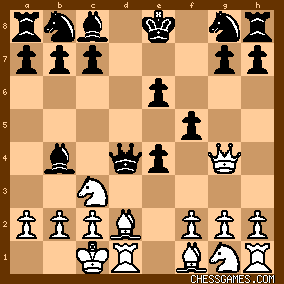
click for larger view7. Bg5
"?!"--(Soltis)
Gligoric gave 7. Qg3 as best.
"Marshall eyes a rook check at d8 as he offers a third pawn. Thirty years later, when the Winawer had become popular, White strengthened his play with 7. Qg3, with the idea of 7...Bd6 8. Bf4 BxB+ 9. QxB Qc5 10. f3 [10. Qg3 looks better--KEG] Ne7 [10...Nf6 is superior to Soltis' move--KEG] 11. fxe4 [11. Qg5 is best--KEG] 0-0 12. Nf3." -- (Soltis) Marshall does not hold back and throws everything--including the kitchen sink--at Tchigorin. 
click for larger view7... Qxf2
"Black takes a third pawn." (Tournament Book).
Tchigorin might have tried 7...fxQ 8. RxQ Nc6 to cut down Marshall's attacking options. This line would also have given Black better chances. But Tchigorin was also not holding back, and was seemingly confident he could hold his own in a tactical melee against Marshall. After 7...Qxf2, the position was:
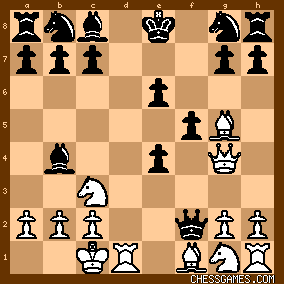
click for larger view8. Qh3?
Marshall here missed 8. Nxe4! which gave him (theoretically) better chances of holding his own. If then: 8...QxB 9. Qg3 QxR+ 10. KxQ fxN 11. Qxc7 Marshall would still have pressure (though Tchigorin would have Rook, Knight, Bishop, and pawn for the sacrificed Queen). If instead 8...fxQ 9. NxQ Nc6 10. Nxg4 Marshall would be only a pawn down with attacking chances. After 8. Qh3?, the position was:

click for larger viewQuite a battle already, and we're only at move 8! |
|
Jul-21-19
 | | KEG: Post III
8... Be7
"!"--(Soltis)
9. Kb1
"Note that 9. Be3? Qh4 allows Black to consolidate comfortably." (Soltis). 
click for larger view9... Bd7
"Tricky play by both sides (9...BxB 10. Qh5+ regains the piece comfortably)." (Soltis). "Timidly played. Simpler was 9. BxB 10. Qh5+ g6." (Tournament Book). Soltis appears to have much the better of this disagreement. Marshall's compensation for his lost pawns would have been much better than in the game after 9...BxB 10. Qh5+ g6 11. QxB Nc6 12. Nh3, although Marshall would still have been hard-pressed to justify his wild sacrificial play. 10. g4?!
"!"--(Soltis)
Here I part company with Soltis. After the ultra-aggressive text, Marshall's game appears to be beyond repair with accurate play by Tchigorin. As will be seen, Tchigorin had many opportunities from this point to consolidate and win with his extra material. However, it must be admitted that--over the board--Marshall's move must have been difficult to meet. The fact that so great a tactician as Tchigorin was unable to navigate his forces to victory from this point shows the practical strength of Marshall's attack. At least theoretically, Marshall would have had better prospects with 10. Be2 or 10. Bc4, though in either case he would have had an uphill struggle. After 10. g4?!, the position was:
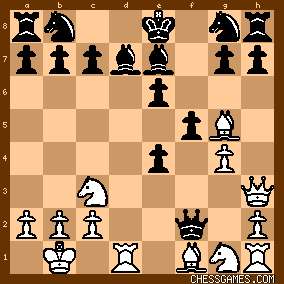
click for larger view10... Nc6
While this was a good practical move that was almost certainly sufficient to win with Black's extra material, Tchigorin could probably have won most simply with 10...fxg4 (e.g., 11. Qe3 QxQ 11. BxQ Nf6 or 11. Be3 Qxc2+ 12. KxQ gxQ 13. Bxh3 Nf6 leaving Tchigorin comfortably four [!"] pawns plus). 11. gxf5
11. Be3 looks somewhat better, but it is tough to play someone like Tchigorin three pawns down! Had I been a spectator, I would not have given Marshall much chance to survive at this point with either the text of my suggested 11. Be3. The text (11. gxf5) did contain more than an ounce of poison as a glance at the position reveals: 
click for larger view11... Qxf5
Tchigorin avoided Marshall's little trap. As the Tournament Book pointed out: if 11...exf5? 12. Nxe4 would follow (after which Tchigorin would have had to walk a tightrope to survive, i.e., 12...Qb6 (if 12...fxN 13. QxB+ wins for White) 13. RxB!--a pretty Rook sacrifice Marshall would undoubtedly have enjoyed being able to play over the board--13...fxN (not 13...KxR 14. Qf5+ Ke8 15. Bc4 and White wins) and now White draws with 14. Be3 Qa5 15. Bd2. Note that after 11...exf5?, White could also draw with 12. Rd2. After Tchigorin's careful 11...Qxf5, Marshall had to submit to a series of exchanges that left Tchigorin very much in charge: 12. BxB QxQ
The temptation to defang Marshall's attack by trading Queens must have been irresistible, but 12...NgxB or 12...NcxB would have been even stronger. After 12...QxQ the position (with Marshall yet to recapture the Queen) was: 
click for larger view |
|
Jul-21-19
 | | KEG: Post IV
13. BxQ
Marshall would have had better chances to save the game with 13. NxQ. His Knights could then have had scope to attack while the f1 Bishop would retain multiple options concerning how and when to enter the battle. 13... KxB
Recapturing with either Knight would have set Marshall more difficult (and probably insuperable) problems. After 13...KxB the position was:

click for larger view14. Nxe4
I am surprised that Marshall--who had plenty of time to pick up the e4 pawn--did not play the more forceful 14. Bg2 giving him better (though likely still insufficient) compensation for his sacrificed material. 14... Nf6
14...Ne5, making room to play Bc6, was better and would probably have led to a decisive advantage for Black. 15. Nc5

click for larger viewMy quibbles notwithstanding, Tcho\igorin was still two pawns up with a safe position. Here, however, he faltered badly with: 15... Nd8?
A shockingly weak reply from Tchigorin. 15...b6 would have forced Marshall either to retreat his Knight (after which his attack would seem to be pretty much at an end) or else trade with 16. NxB (best) NxN after which Black should win the ending. 16. Nf3?
Right piece wrong square. With 16. Ne2! Bc8 17. Nd4 Marshall's attack may well have been sufficient for him to survive. After the text, Tchigorin was able to consolidate and was seemingly about to capitalize on his material edge. 16... Bc6
Taking advantage of 16. Nf3? with a nasty pin.
17. Rhf1 b6
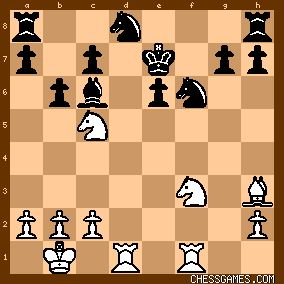
click for larger view"Black has kept two of his [three] pawns and appears to have a direct route to victory. But Marshall now illustrates why he became known as 'der findigreiche Amerikaner'--the American who always managed to come up with a resource." (Soltis). 18. Nxe6
"!"--(Soltis)
The text is indeed pretty. The problem is that it loses, as will shortly be apparent. Marshall's best chance was 18. Nd3, unsatisfying as that move would have been in Marshall's attacking scheme. 18... NxN
19. Rde1 Ne4
As Soltis notes, after 19...Be4 20. Nd2 Marshall would have regained the piece (with better chances than in the game). But in Soltis' variation, Tchigorin would have retained winning chances with 20...Ng5 (instead of Soltis' suggested 20...Bd5? 21. c4 putting Marshall back in business with excellent chances to save the game). 20. Bf5

click for larger viewMarshall was now only one pawn down. But here Tchigorin missed a chance that might have stopped Marshall in his tracks. |
|
Jul-21-19
 | | OhioChessFan: Surely 50. Rxg2 was easier. |
|
Jul-22-19
 | | KEG: Post V
20... N6e5
While the text was almost certainly sufficient to win, even stronger and more immediately decisive was 20...Bb5! Marshall would have had to play 21. BxN after which would follow: 21...BxR 22. BxR RxB 23. RxB Rf8 and now Marshall would have had to allow Tchigorin to reduce to a Knight and pawn ending he almost certainly had no difficulty in winning. After Tchigorin's actual 20...N6c5, the game was still complicated: 
click for larger view21. b4?!
Marshall was still seeking complications, but the less dramatic 21. Ng5 or 21. Nd2 offered better (but not great) chances. 21... g6!
Pretty much forcing further simplification favorable to Black. 22. BxN
22. Bg4 Ne6 would have been even better for Tchigorin. 22... NxB

click for larger view23. Ng5 Rhf8
Setting a not so subtle trap into which Marshall didn't fall. 24. RxR
Of course if 24. Nxh7?? RxR 25. RxR Nd2+ cleans house. 24... RxR
25. NxN
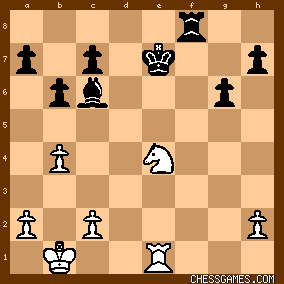
click for larger viewSo Marshall had won back the piece he temporarily sacrificed on move 18, but the game still looks won for Black. 25... BxN
"Tchigorin misses a better chance in 25...Kd7." (Soltis). I agree that Soltis' move is better than swapping minor pieces, but Tchigorin's move also appears to win. Best of all here for Tchigorin was 25...Rf4 . Black's task then seems simpler (e.g., 26. Nc5+ Kd6 27. Rd1+ Bd5 28. Nd3 Rh4 29. Rd2 g5 and it looks all over but the shouting. 26. RxB+ Kd6
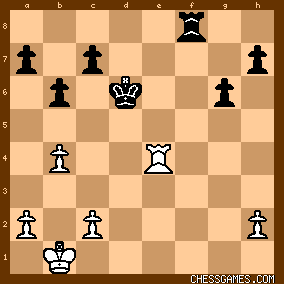
click for larger viewThough this is probably a theoretical winning position for Black, Rook endings are notoriously difficult, and in practice Tchigorin was unable to convert his pawn plus into a win (though--as we will see--he definitely had chances). 27. Rd4+ Ke6
28. Re4+ Kf6
Soltis gives this move as 28...Kd6. As a result, he was looking at a different position from here until 36...Ke5. Much of what follows makes little sense with Black's King on d6. The Tournament Book and this site give the move as 28...Kf6 and I will assume that is correct in the following commentary. 29. Kg2
29. Re3 or 29. Rf4+ were slightly move accurate. 29... g5!
Getting his pawn roller going.
30. b5?!
Marshall should have been looking to get his King over to the other wing with 30. Kc3 or 30. Kc1. If he wanted to force play on the Queen-side, 30. a4 was less weakening. 30... h5!
Soltis here suggests 30...Rf5 which is impossible with the Black King on f6 (but would be an option had Tchigorin played 28...Kd6 as Soltis assumes). After 30...h5!, the position was:
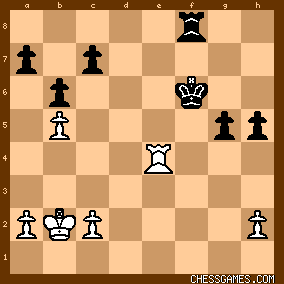
click for larger viewMarshall was in big trouble at this point. With his King out of play on b2, he was in no position to stop the Black pawn steamroller on the King-side. As I will discuss in my next post on this game, Tchigorin should have been able to close out the game from here but missed a win on move 34 after which Marshall escaped with a draw. |
|
Jul-23-19
 | | KEG: Post VI
31. Ra4?!
Ignoring Tchigorin's threats on the King-side and instead targeting the Black pawn at a7. Marshall could instead have tried to get his King over to defend the King side beginning with 31. Kc3, targeted the c-pawn with 31. Rc4, or secured his b5 pawn with 31. c4. The text was the most radical choice. It could have led to grief for Marshall. Since he was probably lost in any case, going for broke here was perhaps a reasonable practical choice (which, as it turned out, worked!). 31... g4!
Ignoring the threat to his a7 pawn and pressing on with his attack. This should--at least theoretically--have led to a win for Black. The text was even better than 31...h4 (which was also probably sufficient for victory). 32. Rxa7?!
32. Kc3 or 32. Rf4+ were more prudent. But following his "in for a penny, in for a pound" approach to this ending, Marshall decided to pick up the a-pawn: 
click for larger view32... Rf7
At first blush, 32...Rc8 looks best. It defends the c7 pawn while denying Marshall the ability to maneuver on the back rank. But, on closer examination, Tchigorin's choice looks just as good and--as will be seen, should have been sufficient to win. 33. Ra8
Taking advantage of what Tchigorin left open to him on the back rank. The attempt to press on the Queen side with 33. a4 seems too slow to stop the Tchigorin express on the other wing: e.g., 33. a4?! h4! 34. a5 g3! 35. hxg3 hxg3 36. axb6 cxb6 37. Ra1 g2 38. Rg1 Rg7 39. c4 Ke5 40. Kc3 Rg3+ 41. Kd2 Kd4 42. Ke2 Rb3! 43. Ra1 Kxc4 44. Kf2 Rb2+ followed by 45. Kxb5; or 39. Kc3 Ke5 40. Kd3 Kf4 41. Ke2 Kg3 42. Ra1 Re7+ 43. Kd3 Kh2 and wins. On balance, Marshall's move looks like the best practical chance. 33... h4!
This should have been decisive.
34. Rh8

click for larger view34... g3?
"?"--(Tournament Book) (Chessical on this site)
"Correct was 34...h3. The text concedes the draw." (Tournament Book). 34...h3 does appear to win. if then 35. a4 Kg6 (better than 35...Kg7 36. Rh4) 36. a5 bxa5 37. Kb3 Rf2 38. Rg8+ Kh5 39. c4 Rxh2 40. Rh8+ Kg5 41. c5 Rf2 42. Kc3 h2 and wins. Even better is Chessical's clever 34...Kg5! (see the excellent analysis of this winning line in Chessical's 2004 post above). Bravo <Chessical> Tchigorin's actual move, 34...g3?, blows the win. It lost a pawn, and Marshall suddenly had a clear road to save the game. Chess can be a cruel game. Tchigorin had been on top thanks to Marshall's over-the-top pawn sacrifices since move 6 and certainly since move 7. After nursing his edge to the brink of victory, this one slip by Tchigorin ended his chances to prevail. After 34...g3?, the position was:

click for larger view35. Rxh4 g2
Perhaps Tchigorin thought this was a winner:

click for larger view36. Rf4+
The fly in the ointment.
36... Ke5
The best chance.
37. Rg4 Rf2
Anything else would lose for Black. But now Tchigorin was the one a pawn down, and a draw was the obvious outcome: 
click for larger view |
|
Jul-24-19
 | | KEG: Post VII
38. Kb3
38. Kc3 (heading to the Queen-side) or 38. h3 immediately (see next move) seem more logical. But the game is draw in any case. 38... Kf5
The simplest drawing route was 38...Kf3+ driving the White King back to Kb2 (since 39. Kc4 or 39. Kb4 would lose instantly to 39...Rf4+). But it appears that--the position notwithstanding--Tchigorin was still trying to lure Marshall into something rash or careless. 39. h3
Though the game is a theoretical draw, Marshall had to watch his step (especially with Tchigorin sitting on the opposite side of the board). There were all sorts of ways for White to lose through carelessness, e.g., 39. Kb4? or 39. Kc4? Rf4+; 39. Rg3 Ke4 40. Kc3?? Rf3+. 39... Ke5

click for larger view40. Kb2 Re2
41. Kc3 Rf2
42. Kb2
Effectively offering a draw
42... Kf5
Tchigorin--perhaps mortified at having let Marshall off the hook, decided to play on for a while. 43. Kb3 Ke6
Playing for complications even at the cost of some (practical, not theoretical) risk. 43...Ke5 or 43...Rf3+ or 43...Re2 were simpler ways to draw. (Black can draw if the King-side pawns are eliminated since three pawns vs. two on the Queen-side is a clear draw. 44. a4
Whether because of the move 45 time control or because he had abandoned any hope of winning, Marshall does not text Tchigorin with the more dangerous 44. Rg5 which would cut off the Black king and at least make Tchigorin sweat. 44... Re2
Still playing for complications or tricks. 44...Ke5 or 44...Kf5 would avoid having his King cut off. 45. Kb2
Again declining to play the more forceful 45. Rg5 (for now, but see move 48). 45... Ke5
46. Kc3 Rf2
47. Kb2 Ke6
Again giving Marshall some scope to press for some advantage. This time, Marshall bites. 48. Rg5
The closest thing to a winning try available. Marshall--after declining to try this twice before--finally gave it a go. 48... Kf6
49. h4
The only way to play for an advantage.

click for larger view49... Rf4
50. Kb3
As OhioChessFan correctly points out, 50. Rxg2 would be the fastest way to eliminate Tchigorin's threats and reach a three versus two pawn (and Rooks) ending that is a clear draw. Marshall, however, decided to muck around for a while, realizing he now had no risks of losing. 50... Rf3+
Tchigorin could have obtained a drawn position with 50...Rxh4 51. Rxg2 Ke6. The next few moves made the result crystal clear. 51. c3 Rf2
52. Rg8 Ke7
53. Rg3 Kd7
54. Rg7+ Kc8
55. h5 Rg5
56. Rxg2
Finally adopting OhioChessFan's suggestion and seemingly bringing the game to and end (i.e., a draw). 56... Rxh5
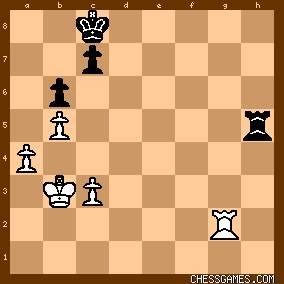
click for larger viewThis is a book draw and the game could safely have been abandoned as a draw here. Indeed, in the original Tournament Book, the score ended here stating "Agreed drawn after further moves." However, the story of this game does not appear to have ended here, and instead--if the score given on this site and in an appendix to the Tournament Book--entered the theater of the absurd as I will discuss in my next post on this game. |
|
Jul-24-19
 | | KEG: Post VIII
An addition to the Tournament Book score, which ran through move 56, was said in an appendix to have been supplied by Jacques N. Pope of Ann Arbor based on "New-Yorker Staats Zeitung, 20th February 1901." This source purports to supply moves 57 though 60. This would all have been well and good had the additional moves made sense. But that was hardly the case. After 56...Rxh5, Marshall (who was a pawn to the good) was the only one with any reason even to try to play for a win in this theoretically drawn position. The moves supplied in the appendix, however, make little sense. 57. a5?
This cannot be a sensible way to play for a win. It left the following position *assuming this additional score was accurate): 
click for larger viewAll of a sudden, lie with Tchigorin assuming he plays 57...Rxb5+ (the most obvious move on the board) 58. Kc5 (or 58. Ka5) Rxa5, leaving Tchigorin a pawn to the good. Simply put, I fail to believe that Marshall played 57. a5? The game was still a theoretical draw, but what sane player would go in for this. But worse was to follow--if we accept this supplemental source: 57... bxa5?
Somehow missing 57...Rxb5+ and leaving Marshall once again with the only one with any reason to play for a win: 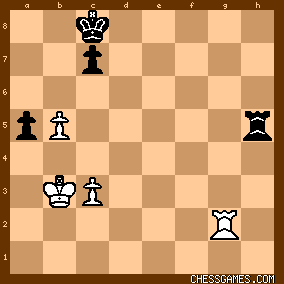
click for larger viewI cannot believe that so fine an endgame player as Tchigorin would have played 57...bxa5? instead of the blatantly obvious 57...Rxb5+ Assuming 57...bxa5 was actually played, Marshall would surely have played 58. c4. Instead, the supplemental source has Marshall playing the ridiculous: 58. Ra2?
This leaves:
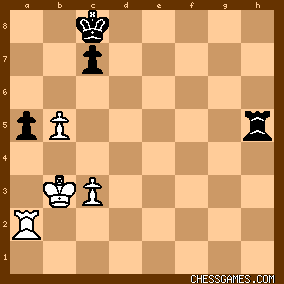
click for larger viewIf this was really played (which I do not believe for a moment), Tchigorin would have been able to win a pawn with the obvious 58...Rxb5+ But instead of 58...Rxb5+, the supplemental source had Tchigorin playing the God-awful: 58... c6?

click for larger viewIf this truly occurred, Marshall would surely have played 59. Rxa5. But, yet again, the supplemental source gives us a loony different move: 59. bxc6?
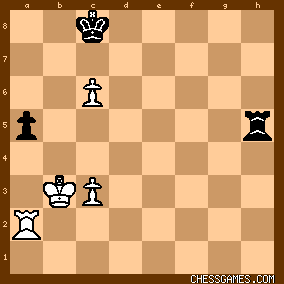
click for larger viewIt would now be difficult for either side to lose, especially after 59...Kc7. The remaining moves, according to the supplemental source, were: 59... Rc5
60. Ra4
Drawn
The one and only nice thing I can say about the supplemental source is that the game remained a theoretical draw from move 56 to move 60. Unless Marshall and Tchigorin were having fun knowing the game was drawn, I cannot imagine that the moves reported in this supplemental source had any basis in reality |
|
|
|
|





